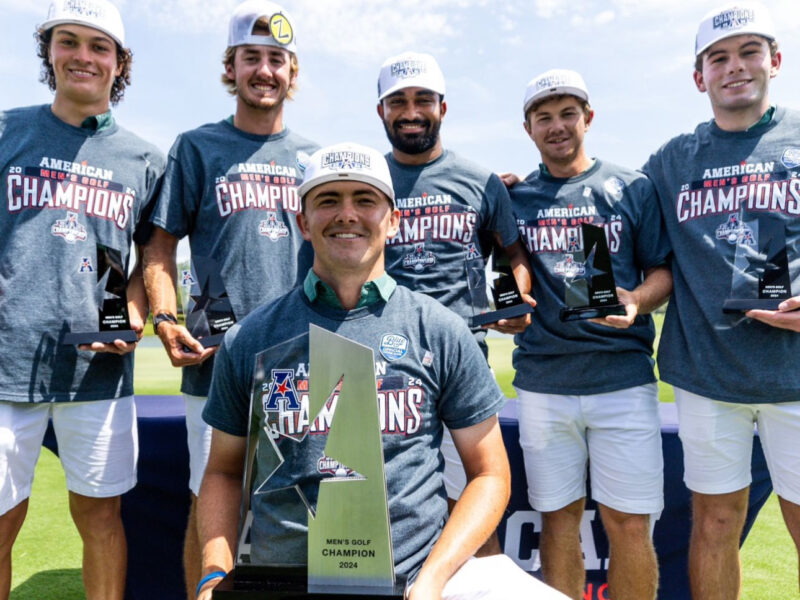Prior to the start of the second Fisheries Symposium held on Nov. 13-15, world-famous artist and ocean-enthusiast Guy Harvey shared his latest documentary, Sharks of the World, with USF St. Petersburg students Wednesday evening.
Harvey is best known for his marine wildlife paintings and work as a marine conservationist.
The film, Sharks of the World: A Guy Harvey Expedition, premiered on PBS a couple of weeks prior and counts down Harvey’s 10 favorite sharks. His goal was to provide the students, and non-students, with a chance to better understand sharks. Armed with several years of hands-on research, Harvey and his team wanted to shred any misconceptions about the creatures.
Harvey started the night off by dedicating the festivities to his friend, Dr. Neil Burnie, who passed away on Nov. 11 in a diving accident unrelated to sharks. Dr. Burnie helped compile some of the tiger-shark footage with Harvey in Bermuda.
After the moment of remembrance for his fallen colleague, Harvey jokingly told the audience that if they were expecting or hoping to see a Shark Week-like depiction of sharks, they should leave the room immediately.
“It’s a result of many different shoots that we kind of coordinated in a really nice presentation,” Harvey said. “Very educational. Gives you a completely different viewpoint from the Discovery Channel Shark Week bonanza that you get.”
In the movie, narrated by Harvey, Harvey and several members of his team swim without the protection of cages. But as the swarming cloud of various shark species feast on nearby fish and bait, they pay little attention to their human guests.
“I like ‘em all,” Harvey said. “I like the big ones. You know, the sharky-looking sharks.”
Harvey believes that the press has turned sharks into something more evil than what they really are and that there hasn’t been enough research compiled on the more than 400 different species of sharks for generalizations to be placed.
“What we’re trying to do is just try and learn more about the animals and then take our experience and turn it into a story to tell the general public,” Harvey said. “And it should come across that these are amazing animals. They have a very significant and important role in the open ocean and in coral reef situations and they need our respect.”
As seen at the top of the list in the film, Harvey expressed which sharks he likes a bit more than most.
“I think between the tiger and the oceanic white tip are my two favorites,” Harvey said. “I mean, everyone loves the white shark but they’re really not as approachable as some of the other sharks, just because of their size and their ability to kind of take care of you.”
After two years, The Guy Harvey Fisheries Symposium came back to USFSP. The event provides Harvey and his team with data that has been collected through various presentations and research papers submitted.
Harvey covered several topics, including oil spills and overfishing. Through tracking sharks, Harvey has noticed that these are international issues and countries must work together in order to preserve some of these species.
Harvey also believes the growth of the human population poses the biggest threat to ocean life.
“Our own short sightedness has caused great damage in many places,” Harvey said.
But he does support commercial and recreational fishing, as long as it is responsible and sustainable. He has seen the harm overfishing has on specific species, as well as the damage it does to the ecosystem. But Harvey understands in poorer countries, people need to eat.
“People like to eat fish; I like to eat fish,” Harvey said. “So there’s lots of people to feed. Recreational fishing wouldn’t be able to supply the demand. So, that’s why commercial fishing happens: to supply the demand. It’s like farming almost.”
Harvey believes that the state of Florida has done a good job with putting laws in place and enforcing regulations to avoid such issues as extraction, reef construction, coastal development and pollution.
Harvey works year-round, painting, tagging sharks, informing people on ocean life, and working with his research institute and ocean foundation.
“We got tons of other big projects going on, back at the office,” Harvey said. And ongoing research work, mostly on sharks and billfishes. The art is always ongoing. I’m always painting, so there’s lots going on.”


